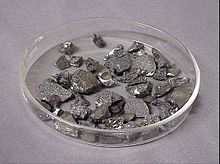Boron
Boron is a chemical element. It has the chemical symbol B. It has the atomic number 5. It is a metalloid (it has properties of a metal and a non-metal). Much boron is found in chemical compounds in its ore borax. Boron is never found free in nature.
 boron (β-rhombohedral)[1] | |||||||||||||||||||||
| Boron | |||||||||||||||||||||
|---|---|---|---|---|---|---|---|---|---|---|---|---|---|---|---|---|---|---|---|---|---|
| Pronunciation | /ˈbɔːrɒn/ | ||||||||||||||||||||
| Allotropes | α-, β-rhombohedral, β-tetragonal (and more) | ||||||||||||||||||||
| Appearance | black-brown | ||||||||||||||||||||
| Standard atomic weight Ar°(B) | |||||||||||||||||||||
| [10.806, 10.821][2] | |||||||||||||||||||||
| Boron in the periodic table | |||||||||||||||||||||
| |||||||||||||||||||||
| Group | group 13 (boron group) | ||||||||||||||||||||
| Period | period 2 | ||||||||||||||||||||
| Block | p-block | ||||||||||||||||||||
| Electron configuration | [He] 2s2 2p1 | ||||||||||||||||||||
| Electrons per shell | 2, 3 | ||||||||||||||||||||
| Physical properties | |||||||||||||||||||||
| Phase at STP | solid | ||||||||||||||||||||
| Melting point | 2349 K (2076 °C, 3769 °F) | ||||||||||||||||||||
| Boiling point | 4200 K (3927 °C, 7101 °F) | ||||||||||||||||||||
| Density when liquid (at m.p.) | 2.08 g/cm3 | ||||||||||||||||||||
| Heat of fusion | 50.2 kJ/mol | ||||||||||||||||||||
| Heat of vaporization | 508 kJ/mol | ||||||||||||||||||||
| Molar heat capacity | 11.087 J/(mol·K) | ||||||||||||||||||||
Vapor pressure
| |||||||||||||||||||||
| Atomic properties | |||||||||||||||||||||
| Oxidation states | −5, −1, 0,[3] +1, +2, +3[4][5] (a mildly acidic oxide) | ||||||||||||||||||||
| Electronegativity | Pauling scale: 2.04 | ||||||||||||||||||||
| Ionization energies |
| ||||||||||||||||||||
| Atomic radius | empirical: 90 pm | ||||||||||||||||||||
| Covalent radius | 84±3 pm | ||||||||||||||||||||
| Van der Waals radius | 192 pm | ||||||||||||||||||||
| Other properties | |||||||||||||||||||||
| Natural occurrence | primordial | ||||||||||||||||||||
| Crystal structure | rhombohedral | ||||||||||||||||||||
| Speed of sound thin rod | 16,200 m/s (at 20 °C) | ||||||||||||||||||||
| Thermal expansion | β form: 5–7 µm/(m⋅K) (at 25 °C)[6] | ||||||||||||||||||||
| Thermal conductivity | 27.4 W/(m⋅K) | ||||||||||||||||||||
| Electrical resistivity | ~106 Ω⋅m (at 20 °C) | ||||||||||||||||||||
| Magnetic ordering | diamagnetic[7] | ||||||||||||||||||||
| Molar magnetic susceptibility | −6.7·10−6 cm3/mol[8] | ||||||||||||||||||||
| Mohs hardness | ~9.5 | ||||||||||||||||||||
| CAS Number | 7440-42-8 | ||||||||||||||||||||
| History | |||||||||||||||||||||
| Discovery | Joseph Louis Gay-Lussac and Louis Jacques Thénard[9] (30 June 1808) | ||||||||||||||||||||
| First isolation | Humphry Davy[10] (9 July 1808) | ||||||||||||||||||||
| Isotopes of boron | |||||||||||||||||||||
| |||||||||||||||||||||

Two types of boron are found (allotropes). Amorphous boron is a brown powder and metallic (crystalline) boron is black and hard and a weak conductor at room temperature. Boron is the 5th element in the periodic table and is part of the Earth's surface. Pure boron is used as a dopant (a substance added to semiconductors to change how it behaves with electricity) in the semiconductor industry. Chemical compounds of boron are important as to make strong materials not weigh very much, as nontoxic insecticides and preservatives, and for chemical synthesis.
Plants need boron in them to live. Very small amounts of boron are needed in animal's bodies so that they are very healthy. How it keeps animals healthy is not known in detail.
Boron was discovered by Sir Humphry Davy, an English chemist, in 1808.
Boron melts at 2075 °C (3767 °F), and boils at 4000 °C (7232 °F).
References
change- ↑ Van Setten et al. 2007, pp. 2460–1
- ↑ "Standard Atomic Weights: Boron". CIAAW. 2009.
- ↑ Braunschweig, H.; Dewhurst, R. D.; Hammond, K.; Mies, J.; Radacki, K.; Vargas, A. (2012). "Ambient-Temperature Isolation of a Compound with a Boron-Boron Triple Bond". Science. 336 (6087): 1420–2. Bibcode:2012Sci...336.1420B. doi:10.1126/science.1221138. PMID 22700924. S2CID 206540959.
- ↑ Zhang, K.Q.; Guo, B.; Braun, V.; Dulick, M.; Bernath, P.F. (1995). "Infrared Emission Spectroscopy of BF and AIF" (PDF). J. Molecular Spectroscopy. 170 (1): 82. Bibcode:1995JMoSp.170...82Z. doi:10.1006/jmsp.1995.1058.
- ↑ Schroeder, Melanie. Eigenschaften von borreichen Boriden und Scandium-Aluminium-Oxid-Carbiden (PDF) (in German). p. 139.
- ↑ Holcombe Jr., C. E.; Smith, D. D.; Lorc, J. D.; Duerlesen, W. K.; Carpenter; D. A. (October 1973). "Physical-Chemical Properties of beta-Rhombohedral Boron". High Temp. Sci. 5 (5): 349–57.
- ↑ Lide, David R., ed. (2000). Magnetic susceptibility of the elements and inorganic compounds, in Handbook of Chemistry and Physics (PDF). CRC press. ISBN 0-8493-0481-4. Archived from the original (PDF) on 2012-01-12.
- ↑ Weast, Robert (1984). CRC, Handbook of Chemistry and Physics. Boca Raton, Florida: Chemical Rubber Company Publishing. pp. E110. ISBN 0-8493-0464-4.
- ↑ Gay Lussac, J.L.; Thenard, L.J. (1808). "Sur la décomposition et la recomposition de l'acide boracique". Annales de chimie. 68: 169–174.
- ↑ Davy H (1809). "An account of some new analytical researches on the nature of certain bodies, particularly the alkalies, phosphorus, sulphur, carbonaceous matter, and the acids hitherto undecomposed: with some general observations on chemical theory". Philosophical Transactions of the Royal Society of London. 99: 39–104. doi:10.1098/rstl.1809.0005. S2CID 98814859.
- ↑ Zhang, K.Q.; Guo, B.; Braun, V.; Dulick, M.; Bernath, P.F. (1995). "Infrared Emission Spectroscopy of BF and AIF" (PDF). J. Molecular Spectroscopy. 170 (1): 82. Bibcode:1995JMoSp.170...82Z. doi:10.1006/jmsp.1995.1058.
- ↑ Melanie Schroeder. "Eigenschaften von borreichen Boriden und Scandium-Aluminium-Oxid-Carbiden" (PDF) (in German). p. 139.
- ↑ 13.0 13.1 "Atomic Weights and Isotopic Compositions for All Elements". National Institute of Standards and Technology. Retrieved 2008-09-21.
- ↑ Szegedi, S.; Váradi, M.; Buczkó, Cs. M.; Várnagy, M.; Sztaricskai, T. (1990). "Determination of boron in glass by neutron transmission method". Journal of Radioanalytical and Nuclear Chemistry Letters. 146 (3): 177. doi:10.1007/BF02165219. S2CID 95777594.

